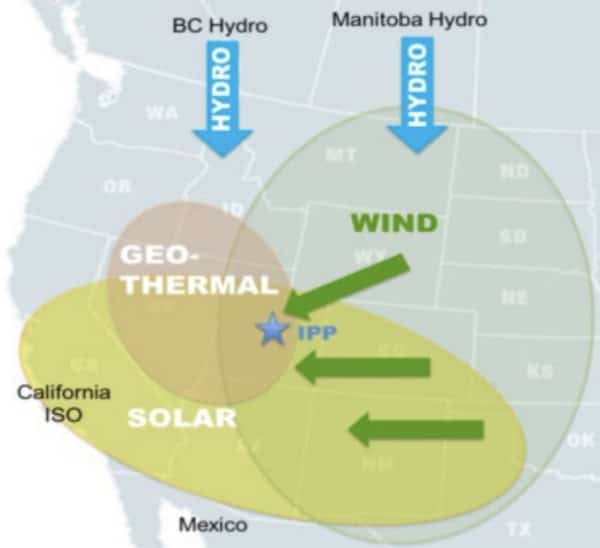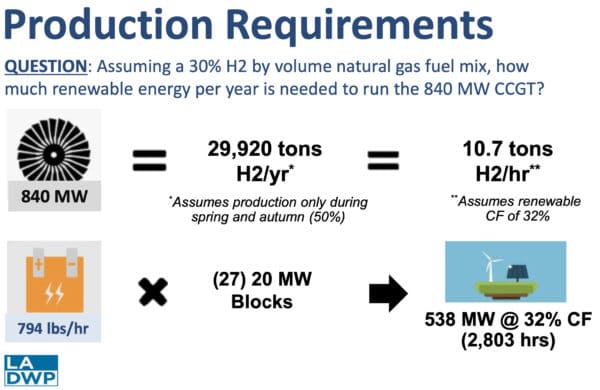With a green hydrogen project now being planned for Utah, the biggest question is how much it will cost. Supporters hope that green hydrogen, which is produced from water using solar or wind power, can provide cost-effective long-duration storage to complement renewable generation.
Solar developer 8minute, a founding supporter of the newly launched Green Hydrogen Coalition, takes a sunny view on the cost of producing green hydrogen. CEO Dr. Tom Buttgenbach, noting his firm’s ability to generate solar power at a cost below 2 cents/kWh, says “soon we will be able to utilize virtually free energy from nearby solar power plants that would have otherwise been curtailed, to make low-cost green hydrogen from solar power.”
Buttgenbach’s use of the word “nearby” apparently refers to the Intermountain Power Project in Utah, a coal-fired generator that will be converted first to gas turbines using 30% green hydrogen fuel by volume, and later to turbines using 100% green hydrogen. Buttgenbach made his comments in a press release about the Green Hydrogen Coalition, whose first initiative is supporting the Utah project. Solar developer Intersect Power is also a founding supporter of the coalition, as are SoCalGas and LADWP, the Los Angeles municipal utility.
Taking an alternate view of green hydrogen costs, Paul Schultz, Director of Power External Energy Resources for LADWP, which manages the conversion project, said of green hydrogen, “there’s a recognition that it’s expensive.” Yet he added in an interview, “we’re mandated to increase our renewable percentages, and we have a unique opportunity at this location for production and storage of hydrogen.”
Looking at the big picture on costs is Janice Lin, Green Hydrogen Coalition founder and president. “The cost competitiveness is dependent on many factors,” she said in an interview, which include the cost of the electrolyzers that split water into hydrogen and oxygen, the cost of renewable electricity to run that equipment, and alternative technologies for multi-day and seasonal energy storage.
The 840-MW Intermountain Power Project conversion will require three key technologies, first to make hydrogen from renewable power, then to store the hydrogen, and then to convert the hydrogen to electricity.
Making green hydrogen
Hydrogen can be produced by electrolyzers that split water molecules into hydrogen and oxygen.

An image from an LADWP presentation illustrates the renewable resources available in the area to make hydrogen at the Delta, Utah site.
LADWP projects that starting in 2025, excess generation each spring and autumn from 538 MW of renewable capacity would be used to power the electrolyzers:

A project timeline anticipates that at least 500 MW of solar capacity will be interconnected at the project site in 2023, with 1,000 MW to 1,500 MW of wind power from Wyoming interconnected by 2030.
The water needed for electrolysis would come from Utah’s Sevier River, from which the existing coal-burning plant “has secured enough water rights for its [originally planned] four generating units,” says the LADWP presentation.
GE has published data on the water requirements and electrolysis power requirements,to make enough hydrogen to operate its turbines at 100% hydrogen.
Although LADWP’s presentation does not mention electrolyzer manufacturers being considered, these could include the Hydrogenics division of Cummins, Nel ASA, ITM Power, and Siemens.
Storing hydrogen
The project’s plan for storing hydrogen is shown in the images at the top of this story. LADWP says 100 caverns, each larger than New York’s Empire State Building, could fit in the salt dome. Mitsubishi Hitachi Power Systems has called this part of the plan “the world’s largest renewable storage project.”
Converting hydrogen to electricity
The initial conversion will enable use of a fuel mix of 30% hydrogen by volume, and 70% natural gas, to fuel gas turbines with a combined capacity of 840 MW. Because hydrogen has about one-third the heating value of natural gas by volume, the 30/70 mix will reduce carbon dioxide emissions by about 10% compared to using 100% natural gas.
By 2045, in a second conversion stage, turbines that can use 100% hydrogen fuel will be installed.
LADWP is considering turbines made by GE, Siemens, and Mitsubishi Hitachi Power Systems.
Paul Schultz with LADWP said that the turbine vendors being considered “have told us [that] by 2025 to 2030, they will be testing the 100% [hydrogen] capability in these units, so that still gives us an additional 15 years for them to go through the process of testing and implementing the technology.”
One hundred percent hydrogen fuel could conceivably be used as soon as 2025, indicated LADWP General Manager Martin Adams at the LADWP commissioners meeting in December, as “some of the turbine vendors have told me they may be able to burn 100% hydrogen in 2025.” For that to happen, he said that turbines with that capability would “have to be there,” the issue of nitrogen oxide emissions would need to be resolved, and LADWP would need to work with owners of properties adjacent to the project on “how we would be able to work on [the hydrogen] fuel source with them.”
“We don’t believe that those things will materialize” by 2025, Adams said, “but it’s not that we won’t make every effort to try to get there.”
A November letter from climate advocacy groups to Los Angeles Mayor Eric Garcetti called for pausing the plan for natural gas conversion of the Utah plant while clean energy alternatives “are given serious consideration,” and several citizens spoke out against the gas plant at LADWP’s November commissioners meeting, as reported by Sammy Roth in the Los Angeles Times.
In addition to 840 MW of gas turbines, the project may include a proposed 160-MW compressed air energy storage pilot project, that could “run 100% hydrogen through its generation expansion process,” said LADWP’s presentation.
An MHPS web page says that in the long term the project will include large-scale flow batteries and solid oxide fuel cells.
For future green hydrogen projects, fuel cells that can use hydrogen to generate electricity are a possibility, because at least one firm, Bloom Energy, is developing such fuel cells. And a team at the University of Tennessee, Knoxville aims to develop a reversible fuel cell, to improve the efficiency of the round-trip process of converting electricity to hydrogen and back again.
The Utah green hydrogen project is one of several approaches LADWP is pursuing to reach 100% clean energy by 2045. The National Renewable Energy Laboratory is assisting the utility’s planning process.
“One of the greatest benefits” of converting the Utah plant to green hydrogen, said Janice Lin of the Green Hydrogen Coalition, “is that it gives us hope that a transition to a carbon-free, affordable, sustainable future in multiple sectors is indeed achievable, with green hydrogen.”
This content is protected by copyright and may not be reused. If you want to cooperate with us and would like to reuse some of our content, please contact: editors@pv-magazine.com.








Compressed Air Storage, in Underground Caverns, have been used in Large (MW size) Power Plants for over 30 years and over 100 years elsewhere…. besides the earlier submarinesof the Nineteenth Century.
Not sure where “Overall Efficiency” falls for each option… but key thing is to “recover” the heat/cold (for use) and enhance Overall Efficiency..
As with all combined heat and power, waste heat is only useful if you can put it to use!
Just ask a billion owers of 25% efficient combustion vehicles in the summer.